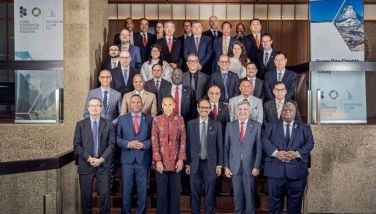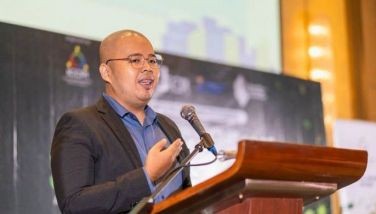The chameleons are off and running

For those of you who don’t know, Webster’s New World Dictionary defines a chameleon as “a lizard with an angular and long tail, eyes that move independently of each other, the ability to change skin color rapidly and a long agile tongue for catching prey.†I might also add that a chameleon is also quick to escape the clutches of a predator and move to higher ground for a better hiding place.
For me, this is actually a pretty accurate description to give our local politicians who change parties in the blink of an eye, gravitate towards whomever is in power, or follow who might be considered the “chief chameleon.†The local chameleons tend to have very little loyalty to their political parties, their platforms, and their promises and when all is said and done move towards the one who has the power.
This is actually the problem of the multi-party system here in the Philippines. It has been happening for quite a while actually. People jump ship as easily as they change their shoes. When I was younger, things were a little more black and white. There were only two political parties to belong to, much like the United States’ Democratic and Republican groups and there was usually one independent party for independent candidates although they rarely, if ever, won in the elections.
Then when Ferdinand Marcos came into power, he destroyed the two-party system and there was only one dominant party — the Kilusang Bagong Lipunan or KBL led by Marcos and his minions. It was an umbrella coalition for parties supporting the then president Marcos, and once he was out of power, was reorganized as a political party in 1986.
After the Marcos reign, President Cory Aquino who succeeded Marcos, brought back the freedom of choice for the people. A Constitutional Convention convened during this time also limited the president to a single six-year term in office. Multiple parties came back with a vengeance and once again politicians allied themselves with like minded people who they felt could best bring them to power.
That is the one thing that has remained true no matter how much Philippine politics has grown and evolved over the years. It is really rare that you will find a politician that will carefully chose the party he/she belongs to because they firmly believe in the party’s platform and politics. Most of the would-be elected officials choose their parties based on power and whomever they think will end up with it when all is said and done. If in the middle of it all they feel that that is another group, they will just as easily defect without second thought. This makes you wonder how committed and dedicated these politicians are. If they can just jump ship on a group that they “believed†in, what’s to say they won’t just as easily jump ship on campaign promises and other beliefs as well.
One of the problems actually is the multi-party system. It has become a glorified “gang†war with sides casting doubt and blame on one another instead of just focusing on their job or their platform. Plus, it really becomes the “strongest kid in the playground†scenario, and despite the party system. Not to mention, it truly doesn’t suit a presidential government, as most officials will naturally gravitate towards the head of state once the election is said and done.
Yet, despite its many flaws and imperfections, this has never been a reason for the government to change the multi-party system via constitutional amendment. Due to the many warring factions and all the media surrounding voters have come to know the parties by their famous members as opposed to by their ideologies. This makes it a “popularity contest†as opposed to a way to truly find the best leaders for our nation. In this type of election system it is the voters who are the most confused and just end up voting for “who they know†as opposed to learning about their potential leaders and then making an educated decision.
I often find myself wondering if this system will change or be made better in my lifetime, but I guess for now we have to take it upon ourselves to truly educate ourselves for the upcoming election, while the many parties (well over 10 by my last count) continue their blame game and “he said/she said†mudslinging as the official campaign period draws ever closer.
* * *
A few weeks ago I remember writing about the US Navy vessel USS Guardian that ran aground in Tubbataha Reef. It was a sad day indeed for divers and nature lovers to know that their beloved paradise that has been protected and preserved for years was damaged so extensively due to faulty navigation. Since then, the pertinent teams and offices have worked non-stop with US counterparts to prepare and plan for a safe extraction of the vessel, and most especially to avoid further damage to the reef.
It has been an intense back-and-forth of ideas with some suggestions not being feasible and some just taking too long. As is, operations are now being undertaken to finally remove the ship, but even that could take days and even weeks. It has to be done very delicately. Time is not an issue here because more importantly than anything is that no more additional and unnecessary damage be inflicted on the reef or any of the surrounding protected areas.
However, it is also important to look ahead. When the extraction is complete that is the only time true damage assessment can be done. A clearer picture will be painted about rehabilitation and how long it will take to fix the damage the grounded vessel cost. In this instance I read in a local broadsheet that the Department of Science and Technology (DOST) has expressed its desire to assist in the reef rehabilitation.
According to them, they have the necessary technology and manpower to help repair the damage to the coral reef in Tubbataha. As part of one of the existing advocacies of DOST is the Coral Reef Restoration Program. This is one of the department’s leading aquamarine initiatives under Science Secretary Mario Montejo. They directly plant corals and help maintain coral reefs all over the country. They are currently maintaining 12 coral nurseries across the Philippines. They also have certified divers who have just completed DOST’s first underwater science and coral reef restoration program just this month.
Hopefully with everyone’s combined efforts, the unfortunate incident in Tubbataha will be rightfully and fully fixed and become just a bad memory we can all learn from.
- Latest
- Trending

























